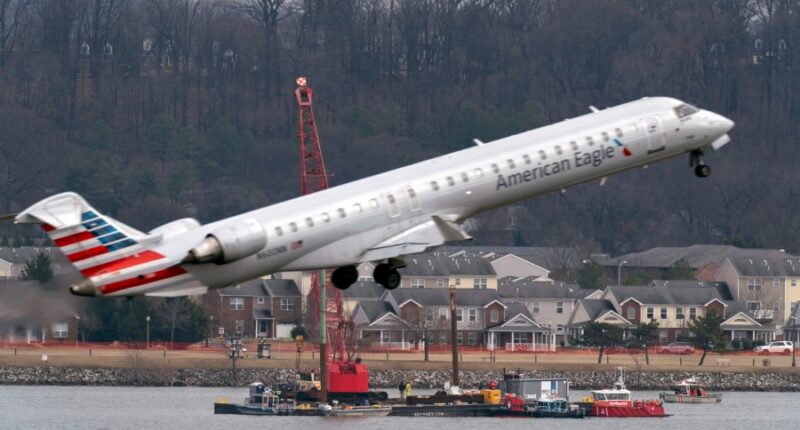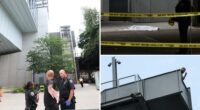Share this @internewscast.com

WASHINGTON () The National Transportation Safety Board opened a three-day hearing Wednesday into a deadly midair collision over Washington, D.C., revealing that a military helicopter was flying above its height limit when it struck a passenger jet.
On Jan. 29, an American Airlines regional jet traveling from Wichita, Kansas, collided with a military Black Hawk helicopter while landing at Reagan National near D.C. Those who died include 64 people who were on the jet and three who were on the UH-60 Black Hawk.
NTSB board member released a video animation showing the path of the helicopter and airliner leading up to the collision. It showed how the helicopter flew above the 200-foot altitude limit before colliding with the plane. Families of victims who were in attendance at the hearing broke down in tears during the final moments of the 11-minute footage.
Investigators on Wednesday said the flight data recorder showed the helicopter was flying 80 to 100 feet higher than was indicated by the barometric altimeter, which pilots rely on to determine altitude. The NTSB conducted tests on three other helicopters from the same unit during a flight over the same area and found similar discrepancies.
Previously disclosed air traffic control audio showed the helicopter pilot telling the controller twice that they saw the airplane and would avoid it. The presentation ended with surveillance video showing the helicopter colliding with the plane in a fiery crash.
It’s likely too early for the board to identify the cause of the crash.
The incident was the first in a string of crashes and near misses this year that have alarmed officials and the traveling public, though statistics show flying remains the safest form of transportation.
Older Black Hawk helicopter models had transmission system issues: NTSB
The NTSB said during the hearing that all eight of the older Lima-model Black Hawk helicopters used by the 12th Aviation Battalion had issues with their ADS-B, or local transmission systems, including the one involved in January’s crash.
The ADS-B systems had an issue where it incorrectly entered time settings, which hindered pilots’ abilities to transmit location data to other aircraft.
It was not discovered or fixed until after the crash on Jan. 29.
The Army has ordered 1,700 new ADS-B systems to upgrade its helicopter fleet, and the 12th Aviation Battalion will be prioritized for receiving these upgrades.
NTSB: Too early to place blame on anyone for the crash
Jennifer Homendy, the chairwoman of the NTSB, said people are often too quick to pin the blame on pilots when crashes happen. She said when people are in the air and know they have a margin of error of 75 feet, they are moving too quickly to do the math.
“We look at man, machine and the environment in which they’re operating,” Homendy said. “It’s possible there was zero pilot error here.”
DOT chief Sean Duffy ‘concerned’ about aviation near-misses
Although the final NTSB report won’t be released until sometime next year, in light of a spate of recent aviation near-misses, Transportation Secretary Sean Duffy told on Tuesday, “Of course, I am concerned. The FAA is concerned. The American people are concerned.”
Duffy told he and his agency are “leaning into” the incidents and looking for solutions: “What is key, we are not ignoring it.”
Culture of near misses led to crash: Father of co-pilot
Investigations have shown the FAA failed to recognize a troubling history of 85 near misses around Reagan Airport in the years before the collision, and that the Army’s helicopters routinely flew around the nation’s capital with a key piece of locating equipment turned off.
Tim Lilley, whose son Sam Lilley was the co-pilot on the American Airlines jet involved in the crash, has demanded answers about the Army’s risk management practices. Speaking to “ Live” on Monday, Lilley criticized what he calls a culture of normalized risk and near misses within military aviation.
“I want to find out when it became commonplace to do dangerous acts in the 12th, like asking for visual separation, when it was a really bad idea,” he said. “We want the Army to analyze data.”
He added, “These 64 victims, they’re not casualties of war. They’re casualties of a culture that decided near misses were okay, because there was many, many near misses that led to this thing.”
Lilley also criticized the Army for what he called a lack of accountability, saying it has hidden behind the NTSB investigation for six months without owning its role in the crash.
The hearings will include investigators and witnesses for organizations involved in the crash. Panelists are expected to focus on military helicopter routes in the Washington area, collision avoidance technology and training for air traffic controllers at Ronald Reagan National Airport, among other subjects.
Aviation officials will also question witnesses and investigators about how the actions of the Federal Aviation Administration, its air traffic controllers, and the Army may have contributed to the nation’s deadliest plane crash since 2001.
Kevin Bohn and the Associated Press contributed to this report.












